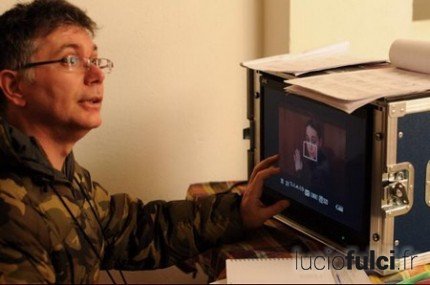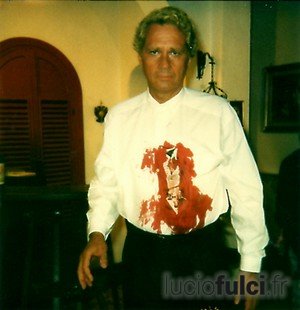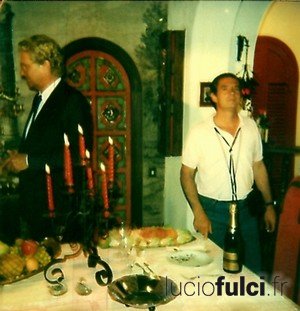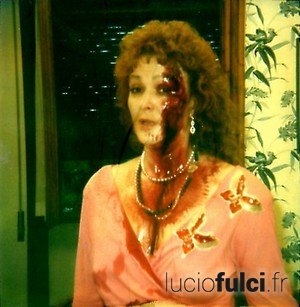
Michele de Angelis – assistant director (Touch od Death, House of Clocks, etc.)
Michele De Angelis worked with Lucio Fulci on several projects in the late 80s. He was around 20 years old and had a great passion for cinema, a passion that still moves him. It’s with pleasure that he agreed to answer some questions about the man he calls his “master”. He also gave us some Polaroids taken during the shooting of Touch of death to illustrate our interview.
Michele de Angelis, you were very young when you first met Lucio Fulci. That must have been an unforgettable experience! Can you tell our readers how you first encountered him?
I had been hired as AD on some movies that Fulci was supposed to present. He was going to direct 2 of them, but we had trouble with a director shooting one, the movie was turning out pretty bad and most of all short! Fulci was asked to take over and put things in order. I offered myself to go and get him at 6.30 am driving 45 km from my house and bringing on set. Nobody wanted to since it was too long but I wanted to meet the guy so badly. I remember asking him all sorts of questions about how he shot a sequence there, how he did this and that. He got out of the car once we arrived and went to the producers asking “Who the fuck is that guy?” Since that day he asked the production to send me every morning to pick him up and bringing him back at night. For me it was kind of hell, working 15-18 hours a day, but too interesting to give up. We had incredible conversations on films, art and even football!
Do you remember the film Fulci finished shooting?
Of course. It was Hansel e Gretel by Giovanni Simonelli. The film was too short. I don’t know what the director and producers had in mind, but they didn’t take the time to know how long the film would be from the screenplay. This one was way too short. Lucio Fulci worked on some additional scenes during one week of shooting, if I remember it wel ; some shots with special effects. Simonelli was an old man at the time, and he was not very interested in his own film. Actually, he didn’t give a fuck! I remember one day we were on the set, ready to shoot, everything set up, and we were just waiting for the instructions of the director… who had disappeared. After some investigation, he was found in the basement of the villa where we shot, admiring old bottles of wine. His son, the production manager, just appeared and disappeared too… it was funny.
By the way, this is the same Giovanni Simonelli that Fulci later wrote the first treatment for A Cat in the Brain? What was the relationship between these two veterans of popular Italian cinema?
I think that Simonelli has nothing in common with Fulci. He had a privileged relationship with the producers. I think he was there to make sure Fulci did his job and remained under control. But in my opinion, most of the good ideas in A Cat in the Brain come from the rewrite done by Antonio Tentori.
You were assistant director on Touch of Death, even if you’re uncredited. Why aren’t you on the credits?
I was assistant in the beginning, but in the end I had some fights with the production company since I sided with Fulci, they hated me. I remember the production manager saying to me last day of shooting, “Congrats for the all the movies you’re going to work in the future with Fulci…definitively not with us!” And I answered “thank god.”
Touch of Death was a low budget movie, but it’s still quite impressive, even if it’s very different from the horror movies Fulci became famous with – it has a strange mix of humour and realism in it. Did Fulci explain to the team what were his aims with Touch of Death?
No he didn’t to the whole crew, just me, the cast, his script girl (daughter Camilla Fulci) It was so much better on paper, along with another one we unfortunately never made: NHF (No Human Factor) but the production…you can’t call it cheap, call it miserable. They weren’t giving us anything…
The mix of black humour was part of Lucio’s personality. He was funny, but always with a bitter, sardonic side.
Do you remember how long the shooting took? Was it an easy experience?
Easy because he was good, even without any means. He knew exactly what he wanted, and when we had nothing he was always able to improvise something interesting. The shooting was less than 3 weeks, let’s say 2 and half.
The same year, you worked on Sodoma’s Ghosts, which is, in my humble opinion, one of Fulci’s less effective horror movies. Was this experience different from Touch of Death? Did you feel Fulci was less interested in that movie?
Same production, same problems; maybe less because they spent a little more money. We shot this before Touch of death. But from one film to another, things were going worse and worse…
Some of the images in Sodoma’s Ghosts, the mansion, the confrontation between youngsters and nazis, recalls a masterpiece of Italian cinema, Pasolini’s last movie, Salo. Did Fulci speak about a link between Sodoma’s Ghosts and Salo?
Not at all, never mentioned it. He just wanted to depict the perversion of a declining power.
Can you tell more about NHF, the unmade project that you’ve mentioned?
NHF, No Human Factor should have been another film in the “Lucio Fulci presents” series. Lucio would have directed the film, the shooting was to be in a strange side of Rome walled Laurentino 28. It’s a hideous recent district built in the 60s with big monolithic buildings. The story took place in the future, a kind of Blade Runner with characters that were not human but synthetic. I remember that the project was really attractive. But with all the problems that we’ve had with the production company, Alfa Cinematografica, it would have been impossible to make a good science-fiction movie without a significant budget. Because of NHF, Lucio broke his contract for the series. He had to make 4 or 5 films, but he would shoot only two. I think that then they agreed that Fulci would direct A Cat in the Brain with some scenes from other films of the series to avoid a trial.
When you talk of production problems, was it just about budgets? Were they supposed to be more important when they signed the contract?
Actually, the budgets were smaller and smaller while the films moved from one producer to another, to another… Scena Films moved the project to Alfa Cinematografica that hired two producers that we nicknamed “the cat and the fox”. When they arrived on the set, you could hear “beware of the pickpockets”. From 700 millions of lires originally intended for each film, we shot with only 210-300 millions.
You’ve also worked on other movies from the “Lucio Fulci Presents” series for Alfa Cinematografica. Was the shooting of Andrea and Mario Bianchi different from Fulci’s, and if so, in what ways?
The directors were different. They really didn’t care too much for the movies. I got along very well with Andrea Bianchi since he was the one to bring me in, giving me the chance to work in the film industry. Mario was a nice man, who didn’t really give a shit about the movie, I believe. He just wanted to bring the thing in the cans as soon as possible. Only movie where I was going home at 3 pm sharp.
How was Fulci with the actors? Was he different with people like Al Cliver or Brett Halsey, with whom he established a strong work relation, than with other actors? He said a few times he got along better with actress than with actors?
He was wonderful with talented people. He was impressed by Jessica Moore, who at that time was trying to get out of the cliché image she had after 11 days and 11 nights. She was kind of good and he was encouraging her to study and don’t give up. With others especially the bad ones, that are often the more arrogant, he was a nightmare. He hated people with no talent that also pretending to have one. So often he was saying something like “good take, you just won a golden bone” implying this way the actor was a dog, a term in Italy we use to define bad talents.
You worked on Fulci’s next projects, the two “House” television movies he made for Reteitalia. This time you’re credited as assistant director, alongside Camilla Fulci. How did you decided who was doing what with Camilla?
Camilla wanted to be a director at that time so she got that credit, but she was still a script girl. Lucio wanted her to become the first European female horror director.
How was Camilla?
Actually, I got along well with Camilla. She was… I don’t know, she was like tormented inside. I don’t know what happened next but she broke off all ties with her family and cinema and I never saw here again after the films we made together. At the time, in any case, she got along very well with her father.
Which “House” was shot first? Did you notice differences between the two shoots?
Not really, much bigger budget and better production company. Shot back to back, if I’m not wrong House of Clocks was second. But as in the other case, the order doesn’t really matter, since we were stopping a day and beginning the new one immediately.
The House of Clocks is a very beautiful movie. It gets close to the metaphysical feelings conveyed by Fulci’s masterpieces. It almost looks like Chirico’s paintings from time to time. How did Fulci explain what he wanted with The House of Clocks?
Lucio was a huge art lover. He had been part of an elite group of intellectuals that dominated the scene in the 50s and 60s. Most of the famous Italian painters were his friends, probably De Chirico as well. He wanted to do something metaphysical since he was fascinated by the flowing of time, and to destroy conventions in narrative filmmaking, as you probably know he was always quoting Artaud as one of the source of inspirations for structures of the story, an apparent nonsense with no guide line, than when edited together made a whole piece of art.
I really love The House of Clocks, but every time I watch the DVD I wonder if the movie looked better the first time it was released. I’m talking about the photography quality, the colour, the definition – now I can ask someone who might know! Is there a big difference between the movie as it was made and the DVD? Would it be possible to have a better copy, do you know if that exists somewhere?
The movies were made for TV, so probably the video master was brightened up to be aired. It would be good to go back to the original 16mm materials to do new high def transfers with new colour grading and correction. 16mm is softer than 35mm because of the format, when transferred to analog SD DVD, is going to look so and so.
The Sweet House of Horrors is not as good as The House of Clocks, mostly because of special effects and pacing problems. Do you know if Fulci was happy with it, and if he tried to rewrite the movie on the set?
There wasn’t any dramatic change. He liked The House of Clocks more, but was kind of happy with both of them, especially after what he experienced with previous productions.
How was Fulci’s general attitude towards screenplays and shooting schedules: did he improvise a lot, or was he following the visual ideas he had before the shooting? On the movies you worked on, was he “editing in the camera”, like Hitchcock, or was he covering every sequences with different scales and angles, in a more traditional way?
I don’t know. He always knew where to place the camera; if he was improvising I wish I could that! He was editing in camera, to avoid producers putting theirs hands on the product. He favoured long tracking shots and cranes, beautifully to watch. He wasn’t covering at all, as I told you he knew exactly what to do and how to achieve it. No need to waste time with many angles just in case; there was no case. Everything matched to perfection.
The Sweet House of Horrors and The House of Clocks seem to share the same structure, with very realistic, almost crude beginnings followed by a sudden jump into fantasy. Did Fulci talk about this?
Well, I believe he was very interested in this change. Even in other movies, like Touch of Death for instance, you believe what is a realistic serial killer film than turns into surrealism. This is very interesting and leaves the viewer puzzled and surprised.
The director of photography on these films was Nino Celeste, a man who worked for TV but had experiences with Bava and Martino. How did he and Fulci work together?
Good. Celeste was actually a good director of photography, fast and doing nice things.
Why did you stop working with Fulci after the “House” films?
I started to do some other projects and Lucio was kind of upset. He had this dominating persona, once you work with him, you work with him full stop. For a while we didn’t speak to each other that much, but then we were on good terms again. He came to a retrospective I did on Italian horror films and was very pleased; he was running a column in a famous newspaper and wrote about the festival in excellent terms.
You are a true cinema lover, obviously – what do you think of these movies and their place in Italian popular cinema?
I like them, even if they don’t match the previous stuff he did. Unfortunately, because of the budget limits and production restrictions.
Do you have another memory about these movies you would like to share?
They were my film school. I learned things that you would never learn in a classroom. The best film school is to work on movies with some professionals and watch them. Then watch all that you can from silent till now. Some young people now don’t realize there’s film history before Tarantino or John Woo.
Do you have a favourite film of Lucio Fulci?
It’s a difficult question. Probably Don’t Torture a Ducking, then The Psychic, Lizard in a Woman’s Skin, City of the Living Dead, The Beyond and House by the Cemetery; those latter ones more or less on the same level.
The last question won’t really be about Fulci, even if there’s an obvious link. You optioned Graham Masterton’s Ritual, to be directed by Mariano Baino. Can you say a few words about the project, how it will look, and what you and Mariano have done so far?
We have been trying to do this for a while. The budget is the limitation, I couldn’t raise enough funds and we want a US star to play in it. But I’ll keep trying. The screenplay is amazing, I believe even better of the original source, it is different but in a positive way.





Leave a Reply